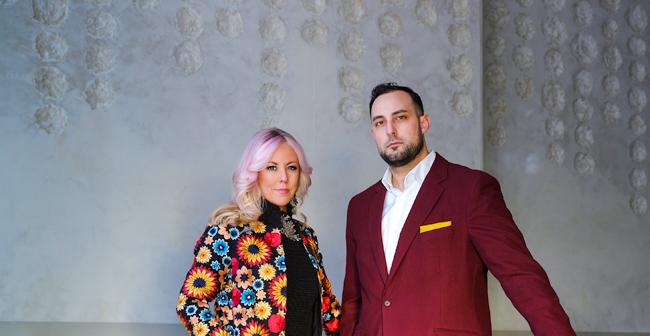Culture
 Photo: Violetta Markelou
Photo: Violetta Markelou
A Day in the Life: Swatchroom’s Maggie O’Neill & Warren Weixler
June 30, 2018 @ 12:00am
An artist and an architect meet in DC, each with their own unique skill set. Realizing that they can accomplish more together, the artist says, “Let’s start a business.” And just like that, design, art and fabrication firm Swatchroom is founded.
While there’s more to their origin story than our abridged version above, a partnership did fall into place in 2013 because both artist and architect saw the strengths that could come with combining their individual experiences. Artist Maggie O’Neill’s background as a painter and designer paired with architect Warren Weixler’s experience at the helm of two design-build firms has made the duo unstoppable in the aesthetic formation of some of the DC area’s most sought-after interiors.
Swatchroom is responsible for the buzzworthy interiors of brand new Poca Madre in Penn Quarter and recently opened Morris American Bar in Shaw, just to name a few. No two Swatchroom designs are alike – the team takes pride in creating spaces that fit the vision of each space to a T while pushing creative boundaries and making people think. Weixler says every client has their own idiosyncrasies and way in which they like to function, so he and O’Neill have to learn what’s important to them and approach each design in a completely individualized way.
The designers are at the forefront of the creative renaissance that’s taken the city by storm over the past few years and continue to work in DC, and even across the globe, on a diverse portfolio of projects. We met the pair in their bustling Shaw studio, where the team was hard at work putting the finishing touches on several projects, to talk about their creative journey.
On Tap: How did you meet each other?
Maggie O’Neill: We met because I was working on a restaurant called Lincoln. [We started] collaborating on fabrication. In cases when I was designing for projects and I couldn’t bring [Warren] in as the architect, he would come in and help me work on a whole host of things.
Warren Weixler: I had a small boutique architecture firm called Design Operative. Around 2008, when the work went away and the bubble burst, I had the choice to lean on some other skill sets I had. When the work started to come back in, I had the choice to either get rid of all that stuff and just go back to only architecture, or to try and incorporate it all together. When Swatchroom started to stir about as an idea, I got really excited because I thought, “I can get away from the technical world of plans and permits and actually live in the architectural world.”
OT: What motivated you to station this brand-new business here in DC?
MO: I was born and raised here. Swatchroom had clients before it existed, so we have a base here. That base also has projects in other cities, which is exciting. That allows us to work in other markets across the U.S. and internationally.
WW: We want to try to lead some of the trends or the ways in which things are done. That’s much harder in a bigger city that’s established. If you go on Google and go to New York City and search “design firms,” like 2,000 pins drop. It doesn’t happen here. It’s growing, but we actually get to affect change in the restaurant industry [with] some of our clients. I think we’re extremely lucky to be in a position to help the growth of a city rather than try to fight everybody else to get jobs.
OT: A large portion of your work is restaurant and bar design. Why are you both drawn to those spaces?
MO: I’m a dreamer all day long, and we want you to use your imagination and to really just push people [to] this sort of Alice in Wonderland moment. You take somebody out of their real life and give them a treat for a little while. There’s just so much joy in that, and the restaurant industry has allowed us to do that.
WW: That is a new trend. How do you blur the lines of what [a space] is? The LINE Hotel is a perfect example of that. Is it a restaurant? Is it a hotel? Is it a workspace? Is it just a cool spot to hang out? It’s all of the above, it’s none of the above. Does it actually matter? Those conversations are really interesting. Rather than saying, “This is an office building, this is a restaurant, this is a hotel,” owners and developers are saying, “It doesn’t matter.”
MO: It’s great because there is no clean answer. I love all that muddiness. This is such a linear city, and it has been for so long. It’s been a city of Democrat versus Republican, “yes” versus “no,” you know – lines. And now there’s so much gray…
WW: …color, there’s so much color!
MO: I’m happy to say, while I don’t think we’re there yet, we’re a hell of a lot better off than we were.
Swatchroom Must-Haves
Music
Plants
Artwork
Natural light
Coffee in the a.m. + bar cart in the p.m.
OT: Your most recent restaurant project is Poca Madre, which opened its doors on June 19. Tell us about your design inspiration for this space.
MO: Victor Albisu is the chef, and he is [also] an artist and a passionate person. The aesthetic is modern Mexican and has this fresh, high contrast to it. It’s a lot of black and white with a ton of greenery and hints of brass, and a few powerful statements aesthetically and potentially politically. It’s a petite environment in that it’s not a big, vast space so wherever you are you will feel a kind of intimacy.
WW: [Albisu] came to us in a moment of growth. He wanted to change Del Campo, which had been around for five years or so, and wanted to bring a Taco Bamba to the city. He said “Okay, I’ll take the front half of the space, because it’s basically a big ‘L,’ and make that Taco Bamba on I Street. Let’s take the remainder and let’s make that this new concept.” We were not only part of the design, but also in helping another business owner get through a growth plateau to reinvent a space that they own.
OT: It sounds like every project you take on is very unique. Talk us through some of the everyday challenges you face.
WW: We have that responsibility as designers to say, “Don’t spend your money on that thing, spend it here,” so I think organizing the budget and the study of how that money works is super interesting. The other challenge from my technical mindset is how we tend to push the envelope on artwork with huge installations, large wall features and such. While all of that is extremely creative and flexible, building code is not. We’ll constantly come up with great ideas but have to worry about sprinkler heads or a fire alarm. How do we push the envelope but make sure it’s legal for the building? It’s fun to play in the conceptual world, but how do you actually execute that? I feel like that’s what we’re good at: figuring out how to get it done and how to get it made and who to use to do it.
OT: Would you say there’s a distinct Swatchroom style? How do you make each space different?
WW: Maybe we have a Swatchroom style, but I don’t know if it’s on purpose. I think we’ve really tried to dig into the narrative of the concept of the client and what that concept means to them and let that drive what the space looks like. We’ll all call each other to the table if we’re trying to repeat a material or a detail or do something again. We force ourselves to stay fresh that way. I think those two things combined have [led to a] portfolio where none of the work looks the same. I’ve even had potential clients come in and ask, “The same people did all of that?” We’re proud of that. It should be different.
OT: You’ve achieved a lot as a design firm in a five-year span. How have your goals changed since 2013?
MO: Our first goal was to figure out how to manage the messaging to people we were already providing our services to. We grew by three or four more people that year, so the skill sets and talents those people brought in was part of our other goal: to actually bring in people that had different expertise [than us]. That way, the conversations and creative problem-solving are better.
WW: It was bootstrapped and organic, and we also made a pact that we’re not going to change for change’s sake, but we’re open to change. In these chapters of your business life, and as trends change, you have to change to stay current and to stay ahead. If we just jam the same process, we may not get the same results. [With] each chapter, we’re like, “Okay, let’s keep growing. Let’s keep changing for the better and keep organizing in different ways.” Luckily, our team is awesome in that they’re open to change, too.
Follow Swatchroom on Instagram at @swatchroom, O’Neill at @maggieoneilldc and Weixler at @warrenweixler. For more on Swatchroom, visit www.swatchroom.com.
Swatchroom: 1301 9th St. NW, DC; 202-808-3343; www.swatchroom.com







